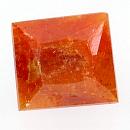|
|
||||||||||||||||
|
||||||||||||||||
|
||||||
|
|
|
|
Vanadinite
|
|
| | |
| Discovered in 1838; IMA status: Valid (pre-IMA; Grandfathered) | ||
|
| ||
|
Chemistry |
|
|
| |
|
Pb5(VO4)3Cl | |
|
|
Lead Chlorovanadinate |
|
Molecular Weight: |
1,416.27 gm |
|
Composition: |
Vanadium |
10.79 % |
V |
19.26 % |
V2O5 |
|
|
Lead |
73.15 % |
Pb |
78.80 % |
PbO |
|
|
Chlorine |
2.50 % |
Cl |
2.50 % |
Cl |
|
|
— |
— % |
Cl | -0.56 % |
-O=Cl2 |
|
|
Oxygen |
13.56 % |
O |
|
|
|
|
|
100.00 % |
|
100.00 % |
= TOTAL OXIDE |
|
|
|
||||
|
Classification |
|
|
| |
|
Phosphates; Vanadates subclass | |
|
7/B.39-170 | |
|
|
8 : PHOSPHATES, ARSENATES, VANADATES
|
|
Related to: |
Apatite Group. The vanadate analogue of Mimetite and Pyromorphite. Mimetite-Vanadinite Series. Pyromorphite-Vanadinite Series. Isostructural with Mimetite, Pyromorphite. |
|
Members of Group: |
Apatite Group: Alforsite, Bellite, Carbonate-rich Fluorapatite, Chlorapatite, Fluorapatite, Hydroxylapatite, Hydroxylapatite-M, Hydroxylpyromorphite, Johnbaumite, Johnbaumite-M, Manganapatite, Mimetite, Mimetite-2M, Miyahisaite, Mn-bearing Fluorapatite, Oxypyromorphite, Pieczkaite, Pyromorphite, Stronadelphite, Svabite, Turneaureite, Unnamed (F-analogue of Pyromorphite), Unnamed (OH-analogue of Mimetite), Vanadinite |
|
Varieties: |
Arsenatian Vanadinite, Cuprian Vanadinite |
|
Synonyms: |
Johnstonite (of Chapman), Lead vanadate, Vanadate of Lead |
|
|
|
|
Crystal Data |
|
|
|
|
|
Typically in well-developed hexagonal prismatic crystals, to 14 cm, short to long along [0001], with {1010}, {0001}, modified by {1120}, {1011}, {2021}, {1121}, many others. Commonly cavernous and in parallel groupings; may be acicular, hairlike, fibrous; rarely rounded, globular. |
|
|
None |
|
|
|
|
|
Physical Properties |
|
|
|
|
|
None observed |
|
|
Irregular/uneven, conchoidal |
|
|
Brittle |
|
|
2.5 - 3.0 |
|
|
6.88 (g/cm3); density decreases with the substitution of Ca for Pb; reported values range between ~6.5 to 7.1. |
|
|
None |
|
|
Not Radioactive |
|
|
Other: |
Readily soluble in HNO3 to a yellow solution; soluble in HCl to a green solution with the deposition of lead chloride. |
|
|
|
|
Optical Properties |
|
|
|
|
|
Orange-red, red-brown, brown, bright red, yellow, whitish; pale straw-yellow; colourless or weakly tinted in transmitted light. May exhibit zoned coloration due to varying composition. |
|
|
Transparent, Translucent, Opaque |
|
|
Sub-adamantine, resinous |
|
|
2.416 - 2.350 Uniaxial ( - ) |
|
|
0.066 |
|
|
n/a |
|
|
Weak; visible in tinted material in transmitted light |
|
|
|
|
|
Occurances |
|
|
|
|
|
Geological Setting: |
A secondary mineral in the oxidized zone of lead-bearing deposits, the vanadium leached from wall-rock silicates. |
|
Common Associations: |
Mimetite, Pyromorphite, Descloizite, Mottramite, Wulfenite, Cerussite, Anglesite, Calcite, Barite, iron oxides |
|
Common Impurities: |
P, As, Ca |
|
Type Locality: |
Zimapán, Mun. de Zimapán, Hidalgo, Mexico |
|
Year Discovered: |
1838 |
|
View mineral photos: | |
|
|
|
|
More Information |
|
|
|
|
|
| |
|
|
|
|
Vanadinite
distribution: many localities, even for fine
crystals. From Zimapán, Hidalgo; at San Carlos
and Los Lamentos, Chihuahua; and Rayon, Sonora, Mexico.
In the USA, in Arizona, fine examples from the Old Yuma
mine, near Tucson, Pima County, at the Hamburg, Red
Cloud, and North Geronimo mines, Silver district, La
Paz County, and in the Puzzler mine, Castle Dome district,
Yuma County, from the Mammoth-St. Anthony mine, Tiger,
Pinal County, at the Gallagher mine, near Charleston,
Cochise County, in the Apache mine, Gila County, at
the Western Union mine, near Cerbat, Mohave County;
in New Mexico, from the Hillsboro and Lake Valley districts,
Sierra County. In Morocco, large crystals from Mibladen,
at Taouz, and in the Touissit mine, near Oujda. At Keban,
Turkey. Very large crystals from Abenab, Otavi district,
Namibia. At Broken Hill, New South Wales, Australia.
|
|
|
We
have not photographed our Vanadinite
gems yet. Please
check back soon. |
